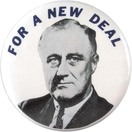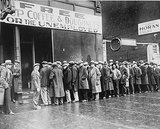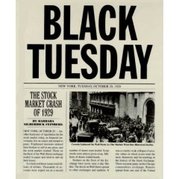The Great Depression
5th Grade Georgia Performance Standards on the Great Depression
SS5H5 The student will explain how the Great Depression and New Deal affected the lives of millions of Americans.
a. Discuss the Stock Market Crash of 1929, Herbert Hoover, Franklin Roosevelt, the Dust Bowl, and soup kitchens.
b. Analyze the main features of the New Deal; include the significance of the Civilian Conservation Corps, Works Progress Administration, and the Tennessee Valley Authority.
c. Discuss important cultural elements of the 1930s; include Duke Ellington, Margaret Mitchell, and Jesse Owens.
a. Discuss the Stock Market Crash of 1929, Herbert Hoover, Franklin Roosevelt, the Dust Bowl, and soup kitchens.
b. Analyze the main features of the New Deal; include the significance of the Civilian Conservation Corps, Works Progress Administration, and the Tennessee Valley Authority.
c. Discuss important cultural elements of the 1930s; include Duke Ellington, Margaret Mitchell, and Jesse Owens.
Herbert HooverHoover is remembered for being the unfortunate president when the stock market crashed in 1929. Everything seemed to go wrong for the next several years, as the farmer's crops failed, the banks went out of business and 25% percent of Americans couldn't find a job. Homeless people lived in shanty towns and called them "Hoovervilles." Even though it is debated if Hoover could actually have done anything to make the Depression end, he had no hope of being reelected, because people blamed all their problems on him.
The New Deal
President Roosevelt was elected in 1932 while America was suffering from the effects of the Great Depression. He promised the American People a New Deal. His New Deal plan was for the government to help meet peoples' needs by creating jobs and government programs to assist the American people. Some of the key programs he created were the Civilian Conservation Corps, the Tennessee Valley Authority and the Works Progress Administration. To get a full understanding of the various programs you will want to visit the links provided, but here is a quick explanation of each program.
Soup Kitchens
Soup kitchens and bread lines were filled with people during the 1930's, because 1 out of 4 Americans did not have a job. The soup kitchen pictured here was compliments of Al Capone the famous Chicago mobster. To view a slide show of soup kitchen pictures, click here.
|
Stock Market Crash of 1929
Throughout the 1920's people began buying stock from many of the thriving businesses. Because the economy was doing so well, people made a lot of money. However, many people foolishly began to borrow money so they could invest more and make even more money. When the stock market lost its value many investors could no longer afford to pay back the money they had borrowed. As a result the banks ran out of money, because they had loaned out so much money. This resulted in a rush on the banks. People desperately tried to get their money out of the bank before the bank ran out of money. Many people lost all of their money. This included many people who had not invested anything! You can find out more about the Crash of '29 here. You can also watch a BrainPop movie about the stock market here.
The Dust BowlThe Dust Bowl happened as a result of drought and poor farming techniques. When tractors were first introduced in the 1920's, farmers began to till up miles of land instead of the few acres that they could do with their horses. When drought hit, the dirt dried up and wind erosion took over. In many cases farmers tilled long straight rows and they worked like wind tunnels. The wind would come and blow down the rows picking up dirt with nothing to stop it. Farmers later learned that they should changed the directions of their crops or leave wind barriers in between their fields.
Visit History.com to see many more videos about the Great Depression |
